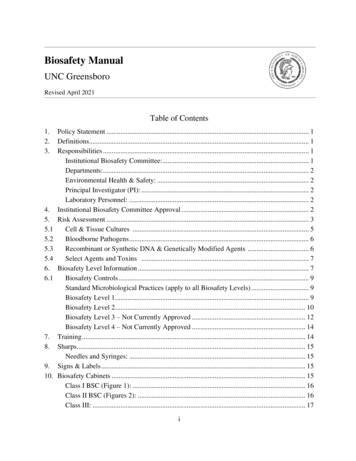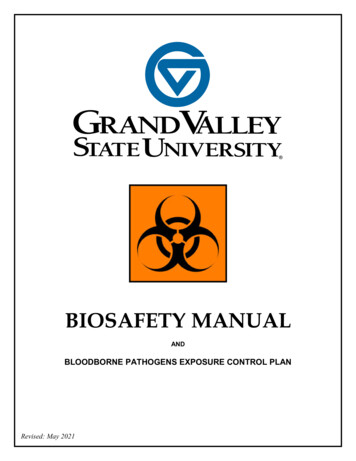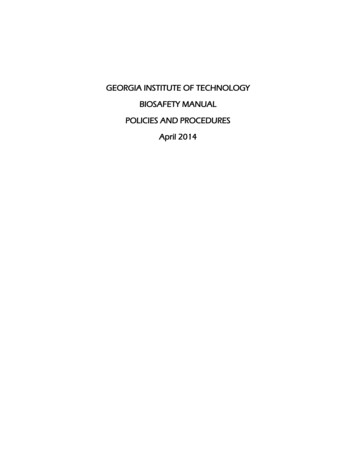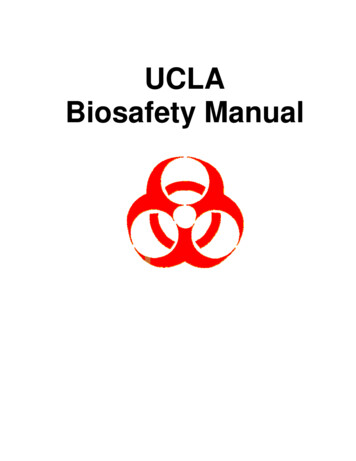
Transcription
UCLABiosafety Manual
Table of Contents1. Laboratory-specific Biosafety Manual Checklist2. Emergency Procedures and Contact Information3. In-lab Biosafety Training Record4. Biosafety Cabinet: Information for Certification, Repairs and Maintenance5. Bloodborne Pathogen Training6. Biological Safety Cabinet Training7. Medical Waste Management Training8. BSL2 Training9. Standard Operating Procedure (SOP)10. Bloodborne Pathogen Standard Exposure Control Plan11. Bloodborne Pathogen OSHA Fact Sheet12. Biosafety Considerations for Research with Lentiviral Vectors13. UCLA Lab Worker HIV/BBP Exposure Information14. Lab Emergency Information
Laboratory-Specific Biosafety Manual ChecklistEach laboratory is required to have a lab-specific biosafety manual and cannot be borrowed or copied fromanother lab. At the time of inspection, applicable documents listed below will be reviewed for completion.For questions please contact the Biosafety Program at biosafety@ehs.ucla.edu or 310-206-3929.Emergency ContactEmergency contact information sheet (Template Issued by Biosafety)— Principal Investigator, Lab Supervisor, Biosafety OfficeAdministrativeCopy of your most current IBC application and approval letter— Include copies of amendment approval lettersCopy of your lab's most recent inspection checklist (Issued by Biosafety)Hazards of Agents (Biohazard Specific)— Technical Data Sheet or information sheet from the vendor (if available)— A brief description of any possible hazards to lab people if exposed. You can use a MSDS orfact sheet print-out from:— Health Canada website: nu— CDC Diseases & Conditions A-Z index .html— Lentivirus Guidance Document from the NIH (cut & paste the link into your web browser toopen the webpage): http://oba.od.nih.gov/rdna rac/rac guidance lentivirus.htmlTrainingCertificates from Biosafety Training (if missing, email Biosafety Program)Handouts from Biosafety Training (most current copy)Lab-specific Safety Training Roster (including occupational health surveillance records)— Lab-specific biosafety training must be given by someone who is experienced in manipulation ofthe biohazard agent being used. All employees must sign and date a training log showing thatthey were trained in the manipulation of biohazard materials.Lab-Specific ProceduresStandard Operating Procedures: must describe, but not limited to the following, (can use Biosafetytemplate)— Personal protective equipment (e.g., lab coat, gloves, etc)— Manipulation, culturing, handling of biohazard materials (lab and/or animal research)— Transport of biohazard materials (lab and/or animal research)— Decontamination (agent, equipment) and disposal procedure including spill clean-up— Procedure to follow if injury or exposure occurs including reportingAgent Summary Sheet (animal research, if applicable)— Required for each agent listed in the Biohazardous Agents section of your ARC protocolProcedure for the Disposal of Biohazardous Animals (Issued by Biosafety, if applicable)Occupational Health and ResourcesExposure Control Plan (Template Issued by Biosafety)OSHA Bloodborne Pathogen fact sheets— Download at http://www.osha.gov/OshDoc/data BloodborneFacts/HIV/BBP Exposure Card 2008 (Issued by Biosafety)CDC/NIH Regulations— Printout relevant sections of CDC/NIH regulations from the BMBL— Download at tmEH&S Biosafety ProgramRevised July 2009X X X X X
Emergency Procedures & Contact InformationPrincipal InvestigatorName:Phone #:Emergency Phone #:Alternate Contact PersonName:Phone #:Emergency Phone #:EH&S310-825-5689 (Main Office)310-206-3929 (Biosafety Main Line)310-825-3323 (Biosafety Officer)UCLA Police Dispatch911 from a campus landline310-825-1491 from a cell phoneWhere to go for Emergency CareStaff & Graduate StudentsOccupational Health Facility, 67-120 CHS, x56771Mon – Fri 7:30 am – 4:30 pmUndergraduate StudentsArthur Ashe Wellness Center (next to the John Wooden Center)Mon – Fri 7:30 am – 4:30 pmAfter hours, holidays, weekends, or for major emergenciesUCLA Emergency Room in the Ronald Reagan Medical CenterEH&S Biosafety ProgramRevised July 2009
In-lab Biosafety Training RecordIn-lab Biosafety training is required before the start of experiments and at least annually thereafter.Training must be conducted by the PI, lab manager or someone else proficient in biosafetyprocedures and techniques that will be used in the lab. For questions contact the Biosafety Programat x63929 or biosafety@ehs.ucla.edu.Principal Investigator:Training Conducted by:The laboratory research personnel listed below have received training in the following topics:Example:Read the Biosafety Manual1.2.3.4.5.Example topics include: Biosafety Manual, emergency procedures, signs and symptoms of exposure,clean-up/decontamination procedures, exposure control plan, etc.Print NameSignatureDateDate Hepatitis BVaccination OfferedEH&S Biosafety ProgramRevised May 2009
Biosafety CabinetCertification, Maintenance & RepairBiosafety Cabinets must be certified: Newly purchased Annually Repaired RelocatedTechnical Safety Services, Inc (TSS)Email ContactLos Angeles OfficeGerry Ruiz562-694-3626gruiz@techsafety.comCorporate OfficeTim g to the UC system contract, Technical Safety Services (TSS) is the only vendorauthorized to service biosafety cabinets at UCLA.The UCLA EH&S Biosafety Program offers training on the safe use of biosafety cabinets.The training is required for personnel using, purchasing, working with infectious materialsunder Biosafety Level 2 or higher (including materials under the Bloodborne PathogensStandard), working with animals requiring biocontainment housing, or other researchrelated projects involving the use of BSC's (also known as tissue culture hoods). Pleasevisit the EH&S website at www.ehs.ucla.edu and click on “Training” for more information.For more information, please contact the UCLA Biosafety Program at 310-206-3929 orbiosafety@ehs.ucla.edu
Bloodborne PathogenStandard TrainingUCLA Environment, Health andSafetyBiosafety Program
Training ObjectivesIdentify the hazards associated with Bloodborne PathogensUnderstand local, state and federal regulationsEnsure proper handling and disposalReview spill response proceduresQuiz
Identify the HazardsBiohazard: An agent of biologicalorigin that has the capacity toproduce harmful effects onhumans; i.e. microorganisms,toxins and allergens derived fromthose organisms, and allergensand toxins derived from plants oranimals.
Overview of Disease Caused by Pathogens Microorganisms are classified into 4 maingroups:BacteriaFungiVirusesParasites
Modes of TransmissionAir – drops of mucus, colds,flu (e.g. tuberculosis)Fecal oral route: enteric usuallyhand to mouth transmission,contaminated water or food (e.g.salmonella, Hepatitis A)Bloodborne
What are Bloodborne Pathogens? Pathogenic microorganisms that arepresent in in human blood, bloodproducts, and blood components andcan cause disease in humans.HIV (Human Immunodeficiency Virus)Hepatitis Viruses (Hepatitis B, C)Agents that cause - Babesiosis- Brucellosis- Leptospirosis- Creutzfeldt-Jakob Disease- HTLV-1 Infections- Arboviral Infections- Malaria- Relapsing Fever- Viral Hemorrhagic Fever- Syphilis
Agents which pose the greatestrisk for Occupational Exposure:– Hepatitis B– Hepatitis C– HIV
Hepatitis B VirusVery infectious!Can live in a dry environment for at least 7 daysSymptoms No Signs– After exposure, it can take 1 – 9 monthsbefore noticeable symptoms arise– Very much like a mild “flu”– Fatigue, possible stomach pain, loss ofappetite, and even nausea 1/3 cases no symptoms, 1/3 flu-like, 1/3 severe Cause inflammation of the liver Liver damage can be mild to fatal Safe and effective vaccine is now available!
Very infectious!Can live outside the body for up to 4 daysOnly 25% of those infected have beendiagnosedSymptomsUsually asymptomatic or have mild symptoms(30 - 90 days) Fever Fatigue Nausea Vomiting Joint Pain Carrier state can develop with or withoutsymptomsCauses cirrhosis and liver cancer Can get some drug therapy but no vaccineHepatitis CVirus (HCV)
Human Immunodeficiency Virus(HIV) Can live in a dry environment for a few hoursSymptoms Some have no symptoms, or less severesymptoms Leads to AIDS Results from destruction of the humanimmune system from infection with HIV No vaccine available, some drug therapy
Risk Factors for HBV, HCV, or HIVInfection Sexual Contact Sharing of hypodermic needles From mothers to their babies at/beforebirth Accidental puncture from contaminated needles, brokenglass, or other sharps Contact between broken or damaged skin and infectedbody fluids Contact between mucous membranes and infected bodyfluids
Major sources of Infectious Pathogens BloodOther Potentially Infectious Materials (OPIM) Human Body Fluids:–––––SemenVaginal secretionsCSF, synovial fluid, pleural fluid, pericardial fluid, peritoneal fluid, and amniotic fluidsaliva in dental proceduresany other body fluid that is visibly contaminated with blood Any unfixed tissue or organ (other than intact skin) from a human (living or dead) Human cells (primary cell lines and purchased cell lines) Any of the following, if known or reasonably likely to contain or be infected with HIV,HBV, or HCV:– Cell, tissue or organ cultures from human or experimental animals.– Blood, organs, or other tissues from experimental animals.– Culture medium or other solutions.
Other Bodily Fluids Not expected to containBloodborne Pathogens unlesscontaminated with visible blood:–Urine–Feces–Vomit–Sweat–Tears
Bloodborne PathogenTransmission Parenteral Exposure– Non-intact skin– Cutting/Piercing skin withcontaminated sharps Mucous Membrane Exposure– Eyes, mouth, nose Transfusion– infected body fluids into anotherperson’s bloodstream
What the government decided to do about it
History of BBP Regulations1970 the Occupational Safety and Health Act, regulated by theOccupational Safety and Health Administration (OSHA), wassigned into law.“An act to assure safe and healthful working conditions for workingmen and women.”On December 6, 1991, the final regulation on occupationalexposure to BBP was issued:“To protect employees from diseases spread by blood inthe workplace.”
Bloodborne Pathogens Standard Regulations:– Federal: 29 CFR 1910.1030– California: Title 8 General Industry SafetyOrders, Section 5193 Purpose:– Prevent exposure (reduce or eliminate thehazards of occupational exposure)– Prevent disease if exposure occurs Regulations apply to:– All employees who could have contact withblood or Other Potentially InfectiousMaterials
Complying with the regulations1. Exposure Response, Prevention & Control– Exposure Control Plan– Exposure Determination– Sharps Injury Log2. Methods of Compliance3. Regulated Waste4. Research Laboratories (eg. BSL2 not covered in thistraining)5. Hepatitis B Vaccination, post-exposure evaluation and follow-up6. Communicating hazards to employees7. Record keeping
1.Exposure Control PlanDevelop and implement controls that will eliminate andminimize employee exposureMust be unique to procedures and locationsMust be reviewed and updated annuallyThis is the responsibility of the Principal Investigator (PI)The following must be included:a. Exposure Determinationb. Controlsc. Standard Precautionsd. General Engineeringe. Specific Engineeringf. Personal Protective Equipment (PPE)g. Housekeeping (decontamination)h. Hepatitis B vaccination, Post exposure evaluation & follow-upi. Communication and trainingj. Recordkeeping
1a.Exposure Determination Do we have jobclassifications where:– All employees are occupationallyexposed? List classifications– Some employees are occupationallyexposed? List classifications List tasks with potential for exposure Determine the exposurerisk without regard forpersonal protectiveequipment the worker uses
1.b Work Place Practice ControlsNo food or drink should bekept in refrigerators,freezers, cabinets, or onshelves or countertopswhere blood or otherpotentially infectiousmaterials are present.
1b. Work Place Practice ControlsHand washing is the single mostimportant thing that you can do toprevent the spread of infection When?DirtyContaminatedwith blood orbody fluidsBefore eatingAfter using therestroomAfter removingyour gloves How?Use tepid water(avoid hot water)Apply soapRub hands togetherfor at least 15 -30secondsCover all surfaces ofthe hands and fingersRinse hands withwaterDry hands thoroughly
1b. Work Place Practice ControlsSharps– Recapping of needles isprohibited– Do not bend, break, or removeneedles– Dispose of sharp objects into asharps container– If no immediate access to asharps container, use the onehanded recap method
1c. Standard or UniversalPrecautionsTreat all human blood, other potentiallyinfectious body materials, andunidentifiable body fluids as if they wereknown to be infectious
1d.Engineering ControlsIsolate or remove the bloodborne pathogenhazard from the workplace
1d. General EngineeringVentilations hoods, Biosafety Cabinets
1d. General Engineering Secondary TransportContainer Sharps disposalcontainers– Closable– Puncture resistant– Leakproof– Labeled
1d. Specific EngineeringBiohazard Plastic ShieldSealed rotor heads orcentrifuge safety cups
1d. Specific Engineering Use safer sharpdevices– Needleless IV systems– Retractable syringesand lancets– Puncture-resistantcapillary tubes
1e. Personal Protective Equipment (PPE)– Must be provided at no cost to theemployee– Based on risk assessment(procedure, locations, hazard, etc)– Wear a minimum of a lab coat andgloves– When splashing is anticipated orwhen handling highly concentratedmaterials wear eye protection, faceprotection, disposable gowns, anddouble gloves
1e. Personal Protective Equipment (PPE)Know how to use PPE Properly– Change gloves when compromised,damaged, or contaminated– Wash hands between glove use– Remove PPE before leaving the work area(no gloves in the hallways!)
1f. Housekeeping Maintain a clean & sanitary workplace Written cleaning & decontaminationschedule Laundry – employer shall clean, launder,and dispose of PPE at no cost to theemployee Clean and decontaminate all equipment &work surfaces with an appropriatedisinfectant Follow the regulated waste regulations forthe disposal of contaminated wastematerials
1f. HousekeepingWhat is considered Biohazardous Waste? Blood or OPIM (Other PotentiallyInfectious d sharpsLab or medical waste Other items caked with driedblood or OPIM Human cell lines or tissues
Biohazard Bags Must be red in color only!!!Biohazard Waste Containers(Sharps or Bin) At least 1.5 mil in thickness. Can be any color Labeled with the word“BIOHAZARD” & the biohazardsymbol Must be rigid, puncture proof, & leakproof with a tight-fitting lid Bag must be big enough for thecontainer Must be labeled with the word“BIOHAZARD” & the biohazardsymbol on all lateral sides. Only fill up to ¾ full Must be clean Tie in a square knot or gooseneck tie Never overfill - watch the fill-line!X
Know the Rules for Biohazard WasteDisposalDon’t carry a biohazard bag filled with contaminated waste –always use a transport container with a tight-fitting lid!Don’t mix biohazard waste with household waste,radioactive waste, or hazardous chemical waste!Biohazard waste cannot be removed from a red biohazardbag unless authorized by a safety officer or unless the wastehas been pre-treated
Biohazard Waste Violations Unsanitary waste containersUse of orange biohazardbagWaste containers withoutvisible biohazard labelsNon-rigid and no lid wastecontainersOverfilled biohazard wastecontainersSharp items above the fillline of sharps containers
Items that cannot be placedin a Biohazard Bag:Liquid biohazard wasteTreat with disinfectant & pourdown the drain with lots ofrunning waterDo not to pour hazardouschemical disinfectants downthe drain!Urine and feces from animals andhumans – dispose of via a localsewer or as solid waste
PREVENTION
1g. Hepatitis B VaccinationThe best protection against HBV isvaccination.BE WISE!!!IMMUNIZE
1g. Hepatitis B Vaccination Employer must make the Hepatitis B vaccinationavailable– Declination statement required– Available at later date if desired No cost to employees Reasonable time and place If series is interrupted, continue at any timerather than restart series
1g. Hepatitis B Vaccination 3 shot series Effective for 95% of adults Post-vaccination titers for high riskhealth care workers Exposure without vaccination– Immune globulin ASAP after exposure– Begin Vaccination series
EXPOSURE
1h. Bloodborne Pathogens Exposure Incident Contact with blood orOPIM via:– Cuts, puncture, needlesticks– Exposed MucousMembrane– Splash in the Eye– Non-intact skin (eg.dermatitis, abrasions)
1h. Emergency Procedures ifExposed1. Wash the exposed area thoroughlywith soap and running water. Usenon-abrasive, antibacterial soap ifpossible.2. If blood is splashed in the eye ormucous membrane, flush theaffected area with running water forat least 15 minutes.3. Report the exposure to yoursupervisor as soon as possible.
Where to go in case of an exposureincident Staff & Graduate Students:Occupational Health FacilityOpen 7:30 am- 4:30 pm Mon - Frilocated in 67-120 CHS, extension 56771 Undergraduate Students:Arthur Ashe Student Health & Wellness Centerlocated next to the John Wooden Center, extension54073 After hours, weekends, holidays, or for immediatetreatment:UCLA Emergency Room, located in the UCLARonald Reagan Medical Center, call 911
Post Exposure EvaluationEmployer’s Responsibilities: Provide medical evaluation ASAP– Testing for HBV, HCV, HIV– HIV/HBV PEP when indicated Identify source individual, if possible– Obtain consent for blood test Provide information to healthcare provider– Routes of entry– Employee’s job duties– Copy of the regulation Ensure that the healthcare provider provides to exposedemployee:– Results of the source individuals test (if legal)– Results of exposed employee’s test– Post exposure treatment as neededProvided at no cost to employee
Medical Evaluation and Follow-upHealthcare Provider’sResponsibility Provide in writing to employer:– Employee has been informed of theresults– Employee has been informed of anymedical conditions resulting fromexposure All specific findings or diagnoses areconfidential to employee
1i. Biohazard Communication Door card Labels Warning Signs
1j. TrainingIdentify the hazards associated withBloodborne PathogensUnderstand local, state and federalregulationsEnsure proper handling and disposalReview spill response proceduresQuiz
1k. Recordkeeping Medical Records– HBV vaccination status– Written medical opinion ofexposure incidents– Exposure incident details– Maintained for the length ofemployment 30 years Training Records–––––DatesContent summaryTrainer Name & qualificationsAttendee’s names & job titlesMaintain for 3 years
1k. Sharps Injury Log Kept at the Occupational Health Facility (OHF)Maintain a separate sharps injury logDocument sharps injuriesRecorded as confidentiality caseMust contain:– Type and brand of device involved– Department or work area where exposure occurred– An explanation of how the incident occurred
SPILLS!
Biohazard Spill KitFor safe removal of spilled body fluids:– Contain the spill– Remove and dispose of spilled body fluids– Quickly clean and disinfect the spill site EPA approved disinfectantVinyl glovesAbsorbent towelsTongs, spatulasBiohazard waste bag
Spill ProceduresWear proper PPEUse tools (dustpan, tongs, etc.) to pick upsharp objectsContain the spill by placing absorbent papertowels on top of itPour disinfectant on top of the spill all allow itto sit for the required contact timeBleach – 10% solution for 10 minutesClean and rinse the spill areaDispose of all solid waste used for clean up asbiohazardous wasteWash handsReport the spill incident to the supervisor
Emergency Dial 911 (from a landline) UCLA Dispatch (cell phone)– 310-825-1491 UCLA Trouble Desk– On campus: x59236– Off campus: 310-825-9236 EH&S Main Line– On campus: x55689– Off campus: 310-825-5689
UCLA Biosafety ProgramContact Info:Email: biosafety@ehs.ucla.eduWebsite: www.biosafety.ucla.eduPhone Number: Main Office:x55689
Safe Use of BiologicalSafety CabinetsPresented by:UCLA EH&SBiosafety Program1
Objectives Cover how Biological Safety Cabinetsfunction Review guidelines for workpreparations, cabinet procedures, andcleanup operations Video on improvement ofwork habits Review Quiz2
Types of Containment &How They Work3
Utilizing Air FlowAll Engineering solutions to aircontaminationUtilize Air3 Types of ProtectionPersonalProductEnvironmental4
Engineering Solutions to AirContamination5
Chemical Fume Hood Air from inside of thefume hood is expelledoutside of the building Air is not filteredCertification!Air Intake atA minimumOf 75 FPM6
What types of protectiondo you think the Chemical Fume Hood Offers?Personal?YESProduct?NOEnvironment?MAYBE – depends on filters7
Chemical Fume Hoods– How it works Designed to capture chemical vapors/fumes and sweepthem away from the workerOffers personal protection from vapors/fumesDoes not protect the productMay or may not protect the environment from chemicalhazards– What can I use it for? Working with chemicalsTrace amounts of radiationNothing pathogenic8
Horizontal LaminarFlow Cabinet Airflow9
What types of protectiondo you think the Horizontal LaminarFlow Cabinet Offers?Personal?NOProduct?YESEnvironment?NO10
Horizontal Laminar Flow Bench– Not a Biological Safety CabinetDo not use with infectious andhazardous agents!!!Offers product protection onlyClean air is directed across theworkspace toward the user– How it worksWhat can I use it for?Preparation of intravenous mixturesPlant tissue cultureElectronic and mechanical assemblyPharmaceutical proceduresMedia preparationSome animal surgeries11
Biosafety CabinetsThree categories Class I Class II Class III12
Components of Most BSC’s13
Biosafety Cabinets Continuous inward airflow protects you fromaerosols Exhaust air is HEPA filtered to protect theenvironment from becoming contaminated withaerosols HEPA-filtered downward laminar airflow overthe workspace protects the product fromcontamination14
Biosafety Cabinets haveHEPA FiltersHIGHEFFICIENCYPARTICULATEAIRFILTER15
Theoretical HEPA FilterCollection Efficiency If particle size 0.3micron then the filterefficiency is 99.97%. At both smaller than 0.3microns and larger than0.3 microns filterefficiency increases. Does not filter vapor orgas16
UV Light in BSC We DO NOT recommend the use of UV light to sterilizebiosafety cabinets! Can cause skin cancer and burn the cornea! Without proper maintenance the CDC does not recommend using UV light Must be cleaned weekly to clear of dust Must be monitored to ensure that the appropriate intensity of UVlight is emitted (254 nm) Shadows? Don’t get touched by the UV rays! No one is allowed in the room while the UV light is on.17
Location of Class II BSC Keep away from all othersources of airflow––––Open doors & windowsPersonnel trafficSupply air diffuserOther lab equipment Personal & Product protectionare compromised as cross draftsapproach air intake! Must be seismically stabilized(i.e. bolted to the floor)18
BSC must be certified when:1.2.3.4.NewEvery yearIf repairedIf relocatedUniversity of California has a contract withTSS for certification19
Biosafety Cabinet Ducting: Can be connected tobuilding exhaustsystem May use hard orthimble connection20
ClassClassIIII–Personal & EnvironmentalProtection only!Personal, Product, &Environmental Protection!Gas tight work surface21
Class IIClass II AClass II A2Class II Type B1Class II Type B222
Class IIWhat to consider1. Where are the Hepa filters?2. How much air is coming out into the lab?3. What is the pressure in the cabinet ( /-)4. Is the cabinet hard ducted or thimbleconnection?23
Class II Type A1 Exhaust HEPA filtered air may berecirculated into room or exhaustedoutdoors May have positivepressure contaminatedducts and plenums30%70 % Have HEPA filtered recirculated airmixed with HEPA filtered inflow air 70% of air is recirculated May have positive pressurecontaminated ducts and plenumsIntakeMinimum75 FPM NO Volatile, Toxics or Radioradionuclides24
National Sanitation Foundation Standard 49Class II, Type ASuitable for work with agents assigned to biosafety levels 1, 2, 3in the absence of volatile toxic chemicals and volatileradionuclides25
Class II Type A270 % Have HEPA filtered recirculated airmixed with HEPA filtered inflow air –30% of air is recirculated30% All biologically contaminated ductsand plenums under negativepressureIntake All HEPA filtered exhaust can bediscarded outside100 FPMMinimum Minute quantities of volatile toxicchemicals and trace amounts ofradionuclides ok26
National Sanitation Foundation Standard 49Class II, Type A2May be used with agents assigned to biosafety levels 1, 2, 3treated with minute quantities of volatile toxic chemicals andtrace amounts of radionuclides required as an adjunct tomicrobiological studies that will not interfere with the work whenrecirculated in the down flow air.27
Class II Type B1 HEPA filtered down flow air composedlargely of uncontaminated recirculated inflow– 30% of air is recirculated Exhaust most of the contaminated down flowair through a dedicated duct exhausted to theoutside after passing through a HEPA filter Building exhaust system must pull air out ofthe BSC Cannot use Thimble, must use HardConnection70 %Intake30%Minimum100 FPM Have all biologically contaminated ductsand plenums under negative pressureCan use with minute quantities of volatiletoxic chemicals and trace amounts ofradionuclides 28
National Sanitation Foundation Standard 49Class II, Type B1May be used with agents assigned to biosafety levels 1, 2, 3treated with minute quantities of volatile toxic chemicals andtrace amounts of radionuclides required as an adjunct tomicrobiological studies if work is done in the direct exhaustportion of the cabinet, or if the chemicals and radionuclides willnot interfere with the work recirculated in the down flow air.29
Class II Type B2 HaveHEPA filtered down flow air drawnfrom the laboratory or the outside – Norecirculation100% Haveall contaminated ducts andplenums under negative pressure orsurrounded by negative pressure ducts &plenums Exhaustcirculating air to the outsideafter HEPA filtration Building exhaustsystem must pull air out of BSC.Dedicated Exhaust MustIntakeMinimum100 FPMuse hard connection Canuse volatile toxic chemicals andradionuclides30
National Sanitation Foundation Standard 49Class II, Type B2May be used with agents assigned to biosafety level 1, 2, 3treated with volatile toxic chemicals and radionuclides requiredas an adjunct to microbiological studies.31
Working Practices32
Guidelines for working in the BSCNever eat, drink, chew gum, storefood, or smoke nearby33
Guidelines for Working in the BSC1.Store papers or pencils outside of theBSC2.Schedule uninterrupted work times3.One person at a time4.Have arm pits level with bottom of thewindow5.Use slow movements in BSC6.Minimize entering and exiting the BSC7.Do not block any of the grills34
Guidelines for Work Preparations1.Check certification2.Let BSC run for 2 to 3 min.after turning on3.Disinfect all surfaces of the BSC4.Properly position the window5.Close drain valve6.Make sure that all materials needed are inside the BSC7.Segregate clean items from ones that will get contaminated35
Guidelines for Working in the BSCNo open flames in the BSC!ÆDisrupts airflowÆExcessive heat build upÆPossible gas build upÆDamages Hepa Filter36
Don’t let this be your BiosafetyCabinet!37
BSC CleanupBefore and after every procedure! Alcohol Bleach Disinfectant Agent38
Guidelines for BSC Cleanup1.2.3.4.5.6.Equipment that has been in contactwith the research agent are enclosedSurfaces of all equipment aredisinfectedEverything is removed from BSCAll interior surfaces of the BSC aredisinfectedDo not store equipment or supplies inor on the BSCIf possible leave the BSC running39
BSC CleanupIf the BSC must be turned off:1. Do so after a final purgeof two to three minutes2. Close the cabinetwindow completely40
Validation of Decontamination Use RODAC platesto detect presence ofmicroorganisms onsurfaces Fill with mediaappropriate foragents you are using Incubate for 24hours and check forgrowth41
Technical Safety Services(TSS) To schedule service with TSS call1-800-877-7742 Los Angeles Office1-562-694-3626 TSS should schedule servicein 1 to 5 days– Usually within 48 hours42
biosafety@ehs.ucla.eduwww.biosafety.ucla.eduEH&S main line x5568943
MEDICAL WASTEMANAGEMENTUCLA Environment, Health and SafetyBiosafetyProgram
Purpose of the Training To comply with the local, state and federalregulations. To ensure proper handling and disposal. To define roles and responsibilities.
tions
Department of Transportation (DOT) Responsible for protection of public safety inall areas of transportation in the United States. In 1999, medical waste was defined by the DOTas hazardous material.Hazardous material means any substance ormaterial that can burn, explode,
visit the EH&S website at www.ehs.ucla.edu and click on "Training" for more information. For more information, please contact the UCLA Biosafety Program at 310-206-3929 or biosafety@ehs.ucla.edu Technical Safety Services, Inc (TSS) Los Angeles Office 562-694-3626 Corporate Office 800-877-7742 Biosafety Cabinet
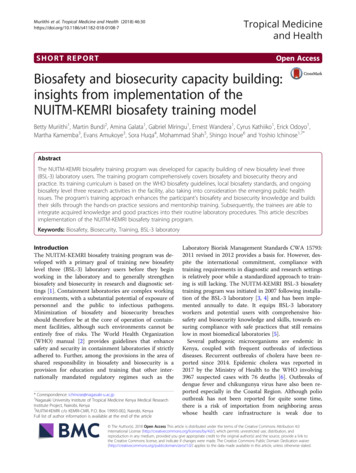
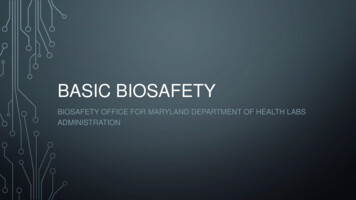
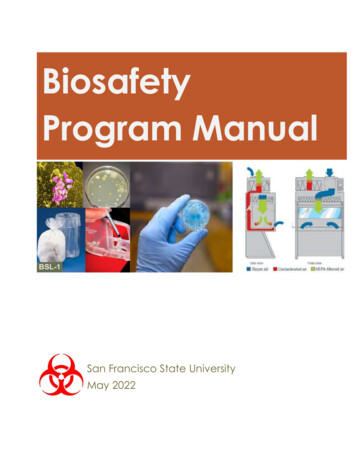
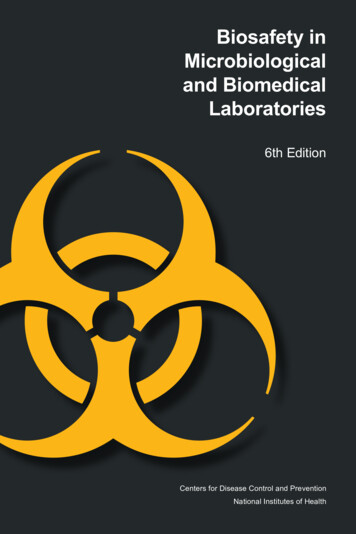
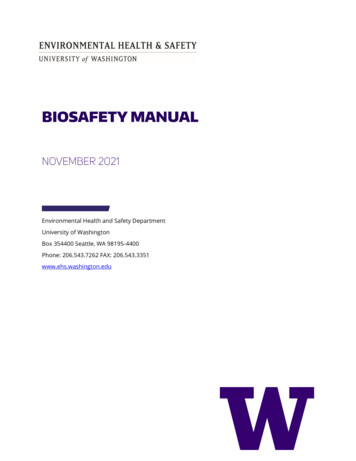
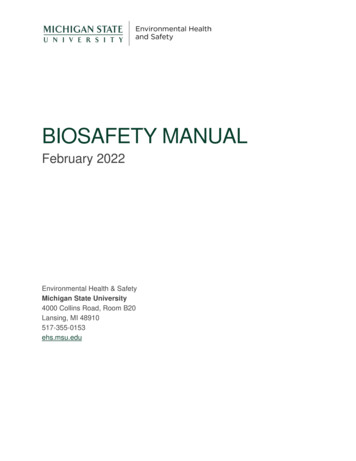
![Biosafety Manual University of Colorado Boulder 120621[80]](/img/25/biosafety-manual-university-of-colorado-boulder.jpg)
